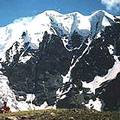 專家在一份新報告中提出警告,亞洲地區包括喜馬拉雅山在內的高山,正面臨道路開發與墾殖迅速擴張、過度放牧及森林消失的威脅。由中國科學院專家提出的最新推測指出,中國高地冰河融化的規模,相當於每年融化掉整條黃河的水量。
專家在一份新報告中提出警告,亞洲地區包括喜馬拉雅山在內的高山,正面臨道路開發與墾殖迅速擴張、過度放牧及森林消失的威脅。由中國科學院專家提出的最新推測指出,中國高地冰河融化的規模,相當於每年融化掉整條黃河的水量。
此現象帶來的隱憂是:在這個區域裡居住了約全世界半數的人口,他們均仰賴自高山冰河與雨季供給用水,冰河融化恐怕將衝擊往後的水資源供給;而同時,這一帶豐富的野生物資源也將受到損害。
聯合國環境規劃署(UNEP)執行長托佛(Klaus Toepfer)表示︰「山區環境具有特別重要的地位,但又特別脆弱。」托佛接著說:「它們是全世界的『水塔』,通常是獨特的野生生物棲息的家園,同時也是在地居民獲取糧食、藥材等重要物資的來源。不過在以往,因為山區地處偏遠,人們常常運用、開發山區資源的方式常未加以控制;不過藉由現代的工程方法,這樣的情況將會改觀。」
這份報告的發表,適逢2005年世界高峰會即將在9月中旬於紐約召開。屆時,世界各國領袖將評估「千禧年發展目標」執行狀況──評估包括將全球無法確保飲用水取得的人口減少一半的任務目標。
該報告指出,若要確保亞洲數十億人口水資源供應無虞,那麼,在永續發展扮演重要一環的「環境管理健全化」出現了嚴重的漏洞。報告中主張,脫序與零零星星的開發,可能會增加森林流失,並因而導致侵蝕作用、污染和其他潛在危害效果迅速擴大。而墾植原始地區作農牧用地的現象,則使情況更加惡化。
研究人員說,目前中國、尼泊爾等國已開始採取行動,包括設置國家公園和保護區等措施,以保育這塊亞洲的水源與野生物命脈。不過他們警告,如果要盡可能縮小惡化的趨勢,現在的努力還不夠,必須將保護區範圍延伸,將低地與山地一起保護起來。
這份報告名為《水資源惡化:世界屋脊水資源與生物多樣性面臨之新興威脅──大規模與零星開發對亞洲低地的衝擊》,目前以公布在網路上,可在以下網址取得:www.globio.info、 www.grida.no、以及www.unep.org,報告內容包含詳實的圖表與地圖資訊。
The mountains of Asia, including the towering Himalayas, are facing accelerating threats from a rapid rise in roads, settlements, overgrazing and deforestation, experts are warning in a new report.
New calculations by experts with the Chinese Academy of Sciences indicate that China’s highland glaciers are shrinking by an amount equivalent to all the water in the giant Yellow River each year.
There is concern that the region’s water supplies, fed by glaciers and the monsoons and vital for around half the world’s population, may be harmed alongside the area’s abundant and rich wildlife.
"Mountain areas are especially important and particularly vulnerable," said Klaus Toepfer, executive director of the UN Environment Programme (UNEP). "These are the water towers of the world and often home to unique wildlife species upon which local people depend for food, medicines and other important materials. They have often been saved from uncontrolled development by their remoteness. But modern engineering methods mean this is no longer the case," he said.
The report is being released in advance of the 2005 World Summit in New York taking place in mid-September. There, heads of state will assess the status of implementation of the Millennium Development Goals, including the target of reducing by half the proportion of people without sustainable access to safe drinking water.
The new report points to a critical gap in the security of the water to billions of people in Asia and the crucial role of sound environmental management for sustainable development. It claims that unchecked and piecemeal development are likely to increase rates of forest loss triggering increased levels of erosion, pollution and other potentially harmful effects. Conversion of pristine areas into farm and grazing land is aggravating the situation.
The researchers said some countries, including China and Nepal, are now acting to develop parks and protected areas aimed at conserving the Asian region’s water supplies and wildlife. But the scientists warn that far more effort is needed to extend protection across the region in lowland and mountain areas if the impacts are to be minimized."The Fall of Water: Emerging threats to the water resources and biodiversity at the roof of the world to Asia’s lowland from changes associated with large-scale settlement and piecemeal development" is available at: www.globio.info and www.grida.no and www.unep.org together with graphics and maps.




